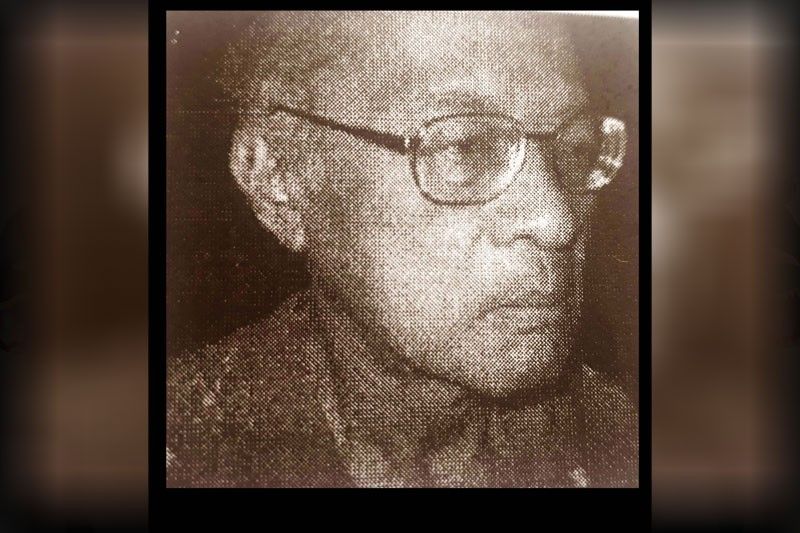Letter from Sonny San Juan


The writer and critic Epifanio San Juan Jr. must be in his 80s by now, and from out of the blue comes a letter from him originally addressed to the paper’s online edition in BGC and subsequently relayed to Port Area, containing clippings of his work including a lecture delivered in his alma mater UP Diliman in March 2018, titled “Diliman Souvenirs” or “Charles Sanders Pierce’s Interpretants and the Return of the Suppressed.”
The letter was handed to me by the chief security, and between sheaf was a short note by Sir Sonny, written behind a nondescript rectangular sized paper that alternately serves as a calling card, but actually isn’t. The cursive states the date: 3/23/2019.
“Dear Juaniyo, kamusta? Greetings from DC! My enclosed lecture of 2018 counter-references to Franz at the end. Kindly share w/ family and friends. Thanks & best wishes, Sonny,” writes the research officer in charge of the Philippine Studies Center in Washington.
Lecture starts off by thanking the chancellor, the chairman of the English department, as well as his co-teacher in the graduate seminar in literary theory. He says it has been a learning experience for him rereading all the philosophers such as Saussure, Foucault, Derrida, and apologizes for using the personal pronoun, as he is mere “allegorical stand-in for the generation that grew up after Liberation, from 1945 to 1965.

“Of course, the speaking subject here cannot be enclosed in that time-space. So it’s puzzling who is speaking, from the viewpoint of the hermeneutics of suspicion,” the professor says.
He recalls it is not the first time for him to teach at Diliman, as he was hired by the “patriarchs of the department” as an instructor in 1958-1960. He laments that many of his contemporaries and mentors have long since passed to “the other shore”: Pete Daroy, Maximo Ramos, Ernie Manalo, Cesar Majul, Alfredo Lagmay.
Some memorable snapshots of the Fifties are mentioned: English 1 teacher Elmer Ordonez assigning “The Gentleman from San Francisco,” as well as that of the old man professor Franz Arcellana, “who wrote slowly on the blackboard, with his left hand, the definition of ‘precis’ taken from the big Harry Shaw textbook.”
Also under the subhead “Historicizing from the Dustbin” does the professor relate how the textbook Approach to Literature by the avatars of New Criticism made a lasting impact, which however did not prevent him from reading Sartre, Camus, Kierkegaard, after befriending fellow heretics in the department.
Another snapshot, or as San Juan put it, short parenthesis: professor NVM Gonzales taking the class to a Manila court hearing of a libel case against writer Estrella Alfon for the alleged obscenity of her story, “Fairy Tale of the City.”
The professor says yet another scenario sticks out: a colleague pestering him to read Spinoza and, voila, four decades later he reads a paper on the selfsame philosopher in Austin, Texas, born out of that mantra spoken by prof Pascual Capiz to one sitting at the far end of the department: Read Spinoza, Sonny, don’t forget Spinoza.
Under the subhead “Interlude,” he says the inevitable interventions to his formalist apprenticeship at the time came in the form of political turmoil — Diliman commune, First Quarter Storm, women’s liberation, and the release of his landmark scholarly book, Carlos Bulosan and the Imagination of the Class Struggle literally on the eve of Marcos’ declaration of martial law.
“The influence of the changes that occurred, in particular the revision of the canon, and the transformation of critical framework/paradigms… overturned my previous New Critical horizon,” he writes.
The subhead “Signifiers Galore” details further turmoil on international scale emanating from “global capitalist earthquake” such as in the Middle East, and events like the fall of the Berlin Wall, demise of the Soviet Union, Tiananmen massacre, election of Trump and his “neofascist America first policy.”
For students to break down this sea change, he urges rereading of Saussure and Jakobson, particularly the former’s “dyadic structure of the sign,” and the latter’s “six functions of language in communication.”
“It is no longer news to learn of the author’s demise,” San Juan references Barthes in the sub “Absent the ‘Author.’” Meaning, the author as an idea is classical and thus final signified, with no more room for intertextuality, and narrators of novels are virtual robots.
He says Foucault has already pointed out that “author-function is historically variable,” and in the final sub “Can Pierce’s Intervention Identify the Speaker?” gets to the prime exhibit, San Juan’s censored Collegian poem, “Man is a Political Animal,” first published in July 1957.
“I am deeply grateful to Franz Arcellana for encouraging me during my undergraduate days, and as a token of this gratitude I wrote the commentary on his short story about Christmas, and on Wings of Madness…
“Personally I did not associate him at all with my suspension — there was no written statement from the UP administration, except a verbal notice from the editor that they won’t print anything from me for a while — because this whole incident was symptomatic of the religious-secular conflict in the University at that time…”
Thanks, Sir Sonny, for remembering the old man in your lecture. Okay at Port Area, though, slouching toward retirement. This is the precis. Regards to DC.



















